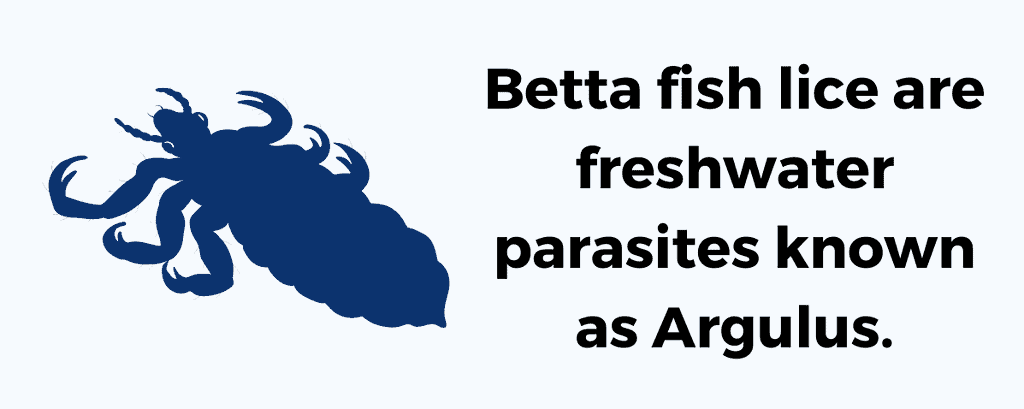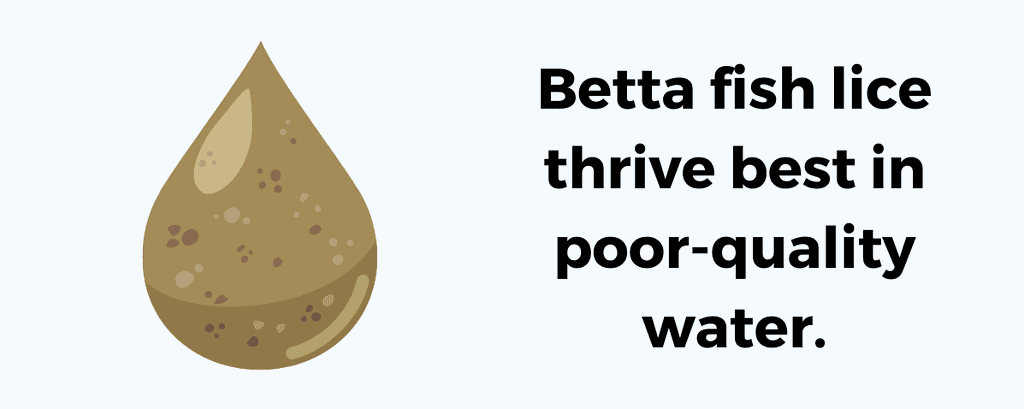Betta fish lice are a common issue in freshwater tanks.
These parasitic crustaceans harm your fish by attaching themselves to the skin and feasting on the blood.
Infected bettas receive damage to their flesh and are susceptible to diseases spread by the lice.
Keeping your fish healthy relies on knowing the signs of betta fish lice in your tank and learning how to prevent and treat the issue.

Table of Contents
What are Betta Fish Lice?

Understanding the enemy is the first step in preventing a betta fish lice outbreak.
Betta fish lice are a type of freshwater parasite known as Argulus.
They are a member of the crustacean family, meaning they have a hard outer covering and go through stages of molting.
Argulus survive by attaching to and feeding off of freshwater fish.
They do this by inserting a stylet into the fish, which delivers enzymes that prepare the flesh for easier digestion.
In addition to hurting the fish’s exterior, the lice can transmit bacteria and diseases.
A sick betta may show signs of:
- Anxiety
- Aggression
- Weight loss
- Anemia
- Lethargy
Life Cycle of Betta Fish Lice

Betta fish lice go through several stages in their lifetime, and the average lifespan of these parasites is from 30 to 60 days.
Learn the Argulus life cycle to better understand what your aquarium is dealing with.
- Egg laying. A female Argulus lays her fertilized eggs on hard surfaces found within the fish tank.
- Hatching (or overwintering). After about 25 days, the eggs hatch. The timeframe can vary depending on the water temperature. The eggs need a water temperature of about 50° degrees Fahrenheit (10° C) to hatch, but they can remain dormant if temperatures are cooler.
- Metanauplius stage. The hatchlings have up to six days to find a suitable host (a.k.a. your unsuspecting betta fish).
- Juvenile stage. The lice feed on the betta or other freshwater fish during this stage. Technically, they can go through this stage up to 10 times in their lifespan.
- Mating. Whenever the juveniles are not feeding, they may engage in free swimming. During this time, they will mate to produce more fertilized eggs.
- Death. At the end of its lifecycle, the betta fish lice will die.
Note: Betta fish lice can lay up to 2000 eggs at one time. Taking care of the problem before it gets out of hand is critical!
Identifying Betta Fish Lice
Argulus lice possess a variety of features to help you identify them:
- Oval-shaped bodies
- Flat design
- Sharp spines along back
- Suction mouth
- Hooks on legs
To better look at the parasites and properly identify them, quickly but carefully remove one of your aquarium fish and examine the lice up close.
If they match the above description, they’re likely betta fish lice (Argulus).
What Causes Betta Fish Lice?

The key to preventing betta fish lice from infesting your aquarium is to understand why infestations happen in the first place.
There are a few different potential causes:
Overcrowding in Tank
Tank overcrowding is a common cause of Argulus infestations.
This is because it allows the infestation to spread faster from fish to fish, thus giving the lice more chances to breed.
Additionally, having too many fish in one tank decreases water quality, which can result in infestations.
Poor Water Quality

Betta fish lice thrive best in poor-quality water, with more opportunities to breed and feed.
It’s critical to make frequent tank water changes and to otherwise ensure the cleanliness of the tank.
Weak Immune System of Fish

Finally, betta fish with weaker immune systems are likelier to develop a lice infestation.
These fish are also more likely to get bacterial infections due to the lice.
Ensure your fish remain healthy by frequently changing the aquarium water and checking their behavior and appearance for abnormalities.
Also, feed your fish a nutritious diet to improve their immune system.
One common option new owners go for is tropical flakes, but the verdict on this isn’t as straightforward as you’d think.
Check out our deep-dive article on betta fish and tropical flakes to learn more.
How To Prevent Betta Fish Lice
Maintaining Proper Tank Conditions
This means ensuring the aquarium meets the following standards for betta fish:
Ideal Water Parameters for a Betta Fish Tank Include the following:
- Temperature: 78-80° degrees Fahrenheit (25.5-27° C)
- pH: 6.5-7.5
- Ammonia and Nitrite: 0 ppm
- Nitrate: < 40 ppm
- gH: 3-4 dGH (50-66.7 ppm)
- kH: 3-5 dKH (53.6-89.4 ppm)
- Minimum Tank Size: 5 Gallons
Regularly Cleaning and Changing the Water
It is critical to regularly clean and change the water in your aquarium—your bettas’ health depends on it!
Frequent water changes ensure betta fish lice levels remain relatively low, as they will have less opportunity to breed.
Keeping the aquarium water clean also promotes general fish health, making them less likely to become sick.
Fungal infections are also a huge concern with unclean tanks.
These are a pain to treat in your Siamese fighting fish, and they often come along with deadly secondary infections.
Quarantining New Fish Before Introducing Them to Your Tank
It is risky to add a new fish to your tank before it’s been quarantined.
Fish can contain parasites without showing symptoms for some time, and these parasites can wreak havoc once introduced to the tank.
Other common contagious diseases like Swim Bladder Disease may also be prevented this way!

Intestinal parasites are a pain when they spread, but it’s manageable if contained in a quarantine tank for treatment.
All it takes is some patience and some anti-parasitic medication.
How To Treat Betta Fish Lice
If your aquarium has betta fish lice, know your options. There are a few things we recommend:
Chemical Treatment Options
Various chemicals and medications are used to treat Argulus infestations. Some of your options include the following:
Organophosphate Pesticides
These include trichlorfon, diflubenzuron, and iufenuron.
While none of these drugs are FDA-approved, fish keepers frequently use them to keep betta fish lice at bay.
| Medicine | Dosage (Active Ingredient) | Usage |
|---|---|---|
| Trichlorfon | 0.25–0.50 mg/L | Apply 1x per week for 4 weeks |
| Diflubenzuron | 0.03 mg/L | After the first treatment, apply another treatment about two weeks later |
| Lufenuron | 0.1mg/L–0.13 mg/L | Apply 1x per week for 5 weeks |
Potassium Permanganate
This is a more accessible option, especially in the United States.
People use potassium permanganate to remove parasites, pollutants, and diseases from their tanks or pools.
Professionals recommend a dosage of a pint per 400 gallons and daily application of the product until the issue is resolved.
Use hydrogen peroxide to neutralize the water afterward.
Natural Treatment Options
If you prefer going the natural route, you have options!
Salt bath
A salt bath is an effective way to cleanse your fish of lice.
We recommend using two teaspoons of non-iodized salt per gallon of water.
For more details on this, check out our aquarium salt and betta fish guide.
Neem oil
A lesser-known option is neem oil. Neem oil comes from the seeds of the neem tree, and people frequently use it as a natural pesticide.
When researchers attempted to eradicate a caligid copepod infestation, they found neem oil was the solution.
“The in vivo test indicated that 10ppm of neem oil could result in 100% antiparasitic efficacy within 96h.”
Nguyen et. al.
How To Remove Lice From Tank and Equipment
Some ways to remove lice from your fish tank and equipment include forceps, a pair of tweezers, or disinfectants.
With forceps, you will manually remove each Argulus. This method is risky, so we recommend letting a professional vet take the reins.
You will deep-clean every aspect of the tank and its equipment with disinfectants.
If done correctly, this will remove the lice from all surfaces, and it’s most effective against eggs.
Prevent Betta Fish Lice Infestations & Give Your Bettas Happy Lives
Betta fish lice infestations are detrimental to your bettas’ health and happiness.
Luckily, there are numerous ways to prevent and treat them to ensure the longevity of your fish.
The best prevention method is to regularly monitor your bettas and their tank.
Watch for irritation or aggression in the fish, and ensure you don’t see any oval-shaped parasites.
For more common betta diseases, check out our list here at the link.


